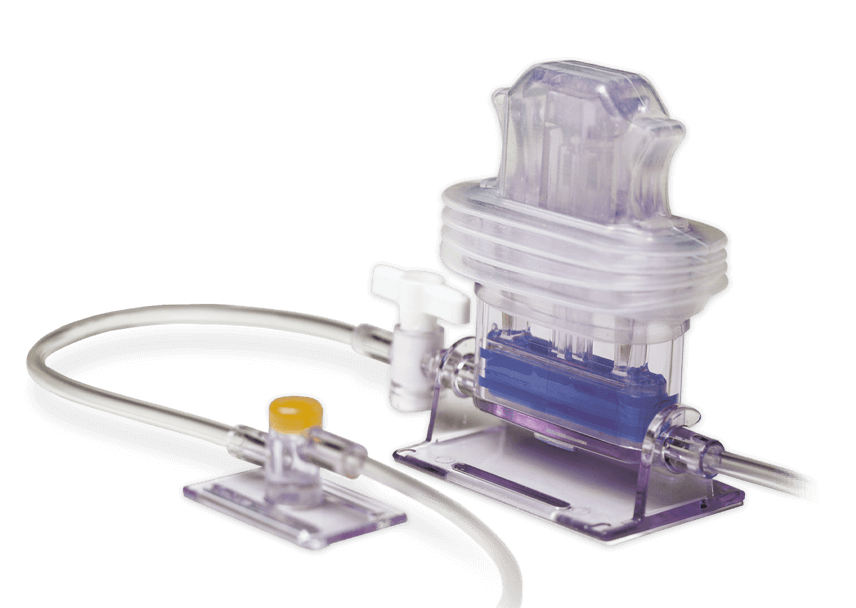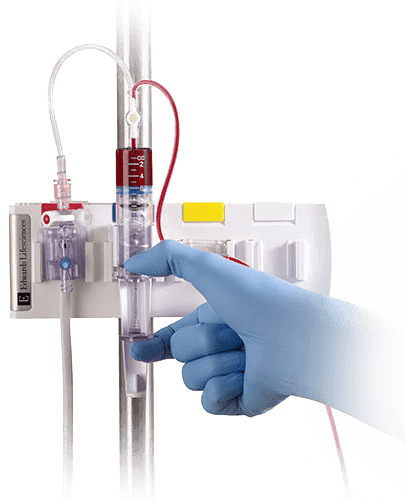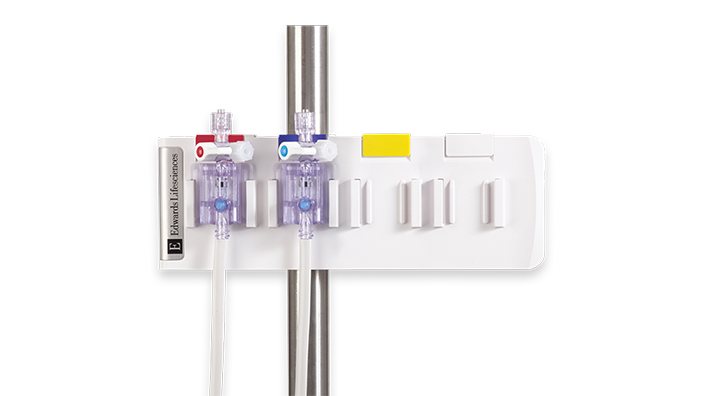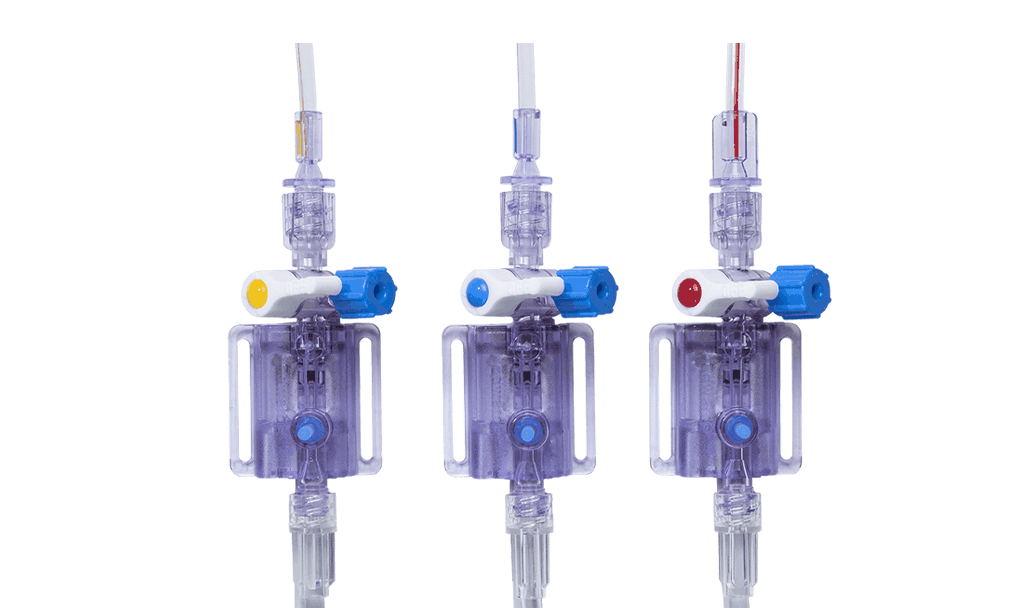Système clos de prélèvement sanguin
Gestion efficace du sang du patient


Système VAMP Adult
Pour minimiser la perte de sang durant le prélèvement, les systèmes clos de prélèvement sanguin VAMP d’Edwards Lifesciences comportent un réservoir en ligne qui permet aux cliniciens de reperfuser plutôt que de jeter le volume de purge. Les systèmes VAMP sans aiguille sont conçus pour réduire les infections, les piqûres et la perte de sang associées aux méthodes de prélèvement de sang habituelles.1-4

Un prélèvement sanguin en système clos sûr, simple et fiable pour une gestion efficace du sang du patient.
- Le système VAMP Adult est conçu pour réduire les infections et les pertes de sang associées aux méthodes de prélèvement de sang traditionnelles.
- Le réservoir de 5 cc est conçu pour un prélèvement sanguin sûr et pratique dans des environnements où une étroite proximité avec le patient est requise
- Doit être utilisé avec des transducteurs de pression à usage unique et pour être raccordé aux cathéters de voie centrale et artériels
- Sa conception flexible lui permet d’être monté sur une potence sur une plaque ou d’être utilisé sur le bras
- L’orifice de prélèvement auto-obturant du site Z réduit l’accumulation de sang lors du recueil d’échantillons non dilués et améliore le contrôle des infections par rapport aux méthodes de prélèvement traditionnelles
Vidéo de configuration du système VAMP Adult
Cette vidéo détaille le processus de configuration et de prélèvement de sang à l’aide du système VAMP Adult associé au transducteur de pression TruWave.
Références de modèle
| Modèle | Description | Unité de mesure |
| 48VMP106 | Kit de prélèvement 6 po, site de prélèvement, réservoir et deux valves d’arrêt | CS(20) |
| 48VMP120 | Kit de prélèvement 20 po, site de prélèvement et réservoir sur le bras | CS(20) |
| 48VMP160 | Kit de prélèvement 60 po, site de prélèvement et réservoir sur le bras | CS(20) |
| 48VMP172 | Kit de prélèvement 72 po, site de prélèvement et réservoir sur le bras | CS(20) |
| 48VMP184 | Kit de prélèvement 84 po, site de prélèvement et réservoir sur le bras | CS(20) |
| 48VMP272 | Kit de prélèvement 72 po, site de prélèvement et réservoir sur potence | CS(20) |
| 48VMP284 | Kit de prélèvement 84 po, site de prélèvement et réservoir sur potence | CS(20) |
Système VAMP Plus

Flexibilité de prélèvement entre la chirurgie et les soins intensifs
- Le grand réservoir de 12 cc permet d’obtenir un volume de purge optimisé
- Choix d’un ou deux sites de prélèvement à site Z pour une plus grande flexibilité en termes de paramètres péri-opératoires
- La manipulation aisée à une seule main simplifie le prélèvement et la réinjection du volume de purge
- Doit être utilisé avec un kit de transducteurs de pression à usage unique et pour être raccordé individuellement aux cathéters de voie centrale ou artériels
Vidéo de configuration du système VAMP Plus
Cette vidéo illustre le processus de configuration et de prélèvement d’un échantillon de sang à partir du système VAMP Plus lorsqu’il est associé au système de surveillance de la pression TruWave.
Références de modèle
| Modèle | Description | Unité de mesure |
| VP1 | Réservoir du système VAMP Plus avec tubulure patient de 60 po et un site de prélèvement situé à 55 po du patient | CS(10) |
| VP2 | Réservoir du système VAMP Plus avec tubulure patient de 60 po et deux sites de prélèvement situés à 13 po et à 55 po du patient | CS(10) |
Système VAMP Jr

Sécurité et précision pour vos patients les plus petits
- Conçu pour répondre aux exigences essentielles en termes de volume pour les patients pédiatriques
- Le réservoir plus petit de 3 cc optimise les volumes de purge, fournissant des prélèvements sanguins précis et non dilués
- Les marquages gradués « cc » aident à sélectionner le volume de purge approprié pour chaque patient
- Le capuchon spécial anti-contamination permet de réduire le risque d’infection
- Une grande variété de longueurs de tubulures pour s’adapter aux exigences de taille des patients
Vidéo de configuration du système VAMP Junior
Cette vidéo illustre les étapes de configuration et de prélèvement d’un échantillon de sang à partir du système VAMP Jr.
Références de modèle
| Modèle | Description | Unité de mesure |
| VMP306 | Kit 6 po avec réservoir de 3 cc et 2 sites d’accès | CS(20) |
| VMP406 | Kit 6 po avec réservoir de 3 cc et 1 site de prélèvement | CS(20) |
| VMP426 | Kit 26 po avec réservoir de 3 cc et 1 site de prélèvement | CS(20) |
| VMP448 | Kit 48 po avec réservoir de 3 cc et 1 site de prélèvement | CS(20) |
Accessoires
Références de modèle
| Modèle | Description | Unité de mesure |
| VMP400 | Canule sans aiguille pour système VAMP | CS(200) |
| VMP700 | Unité de prélèvement direct du système VAMP pour un prélèvement de sang directement sur la ligne | CS(50) |
Edwards : Un atout maître
Chez Edwards, nous mettons tout en œuvre pour offrir à votre établissement, à vos cliniciens et à votre personnel un soutien et un service après-vente irréprochables, afin de garantir une installation harmonieuse et un fonctionnement ininterrompu de vos produits, notamment :
Un support technique 24 h/24 et 7 j/7
Pour obtenir des renseignements sur les produits et les commandes

Laissez-nous vous aider
Références
- Peruzzi, W.T., et al., A clinical evaluation of a blood conservation device in medical intensive care unit patients. Critical care medicine, 1993. 21 (4): p. 501-6
- Oto, J., et al., Comparison of bacterial contamination of blood conservation system and stopcock system arterial sampling lines used in critically ill patients. American Journal of Infection Control, 2012. 40(6): p.530-4
- O'Hare, D. and R.J. Chilvers, Arterial blood sampling practices in intensive care units in England and Wales. Anaesthesia, 2001. 56(6): p. 568-71
- Tang, M., et al,. Closed Blood Conservation Device for Reducing Catheter-Related Infections in Children After Cardiac Surgery. Critical Care Nurse, 2014. 34(5); p.53-61




